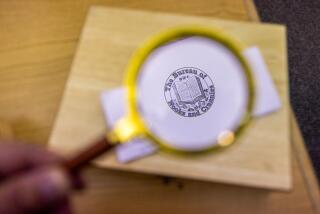Reading Nook: For Rivka Galchen, subways are for reading
My current home in New York City consists of six humans, two small bedrooms and one bathroom. As a child, I lived in a home in a much smaller city with four humans, three bedrooms and two bathrooms. Even then, the only really good place for reading was the bathtub, without the water. It was peaceful in there. No one bothered me or asked me to do something else.
My theory about living in small places in cities is that your apartment extends beyond your apartment. Neighbors take out their garbage in boxers; people in pajama pants are out walking their dogs. They may be on the sidewalk, but what their clothing communicates is that even on the sidewalk, they are in their own homes.
Thus, my dearest reading nook is on the subway, especially the 2 and 3 trains, but with special respect for the F train, which has the highest incidence of fellow readers.
On the subway, there is blissfully, usually, nothing distracting me. Except for all the things I want to be distracted from, such as the latest Casper mattress advertising campaign or the train being stalled in a tunnel, or an announcement of a medical emergency. The subway is as powerful as the dry bathtub: no one asks anything of me there. Reading on the subway is as focused and intense as reading was in childhood, when books were other worlds that felt more credible even than my own. Since an average day for me has four to six subway rides in it, the subway reading nook gifts me around a third of a novel a day.
Unless the novel is magically long.
Iâve been reading long ago and faraway of late. More than usual. Maybe because the this-just-happened news is on the handheld screens of other riders, mutely shouting in what I like to think of as the quiet car. I recently reread Wilkie Collinsâ âThe Moonstone,â a solid weekâs worth of subway rides. The epistolary form of the 1868 novel matched the punctuated reading of the subway nook. Iâve also been reading more nonfiction. I recently read the writings of Julian of Norwich, whom before I had only read about. She was an anchorite who detailed her ecstatic visions of God, whom she saw as a mother. This was a thousand years ago. I hadnât even understood what an anchorite was. It used to be a normal practice to lock someone away in a small room off the church and never let them out again â and this wasnât a punishment. Families and friends sometimes held funeral services for the person going into isolation. In other instances, anchorites became wise people to visit and from whom to seek council. It doesnât sound like a good situation â it sounds like a primitive solution for handling difficult people â but I do think, if properly equipped, it might be a nice place to read. After Julian of Norwich, I started C.V. Wedgwoodâs âThe Thirty Years War.â Reading about horrible times from the past â times that are already over â makes me feel curiously calm and hopeful.
When I first moved to the city, I used to dream of riding the subways from end to end, making sure to take each line over its entire course. I donât really know why, or what I thought I would see. Even on an elevated train, you mostly miss the neighborhoods you are passing through. But the subway already seemed like one of the best places in the city, and this was even before air conditioning. The subway wasnât a reading nook back then, when my home, however small, was quiet. Maybe, back then, the subway was the other kind of reading: the reading of the visible world. Nowadays I hardly notice the other riders, unless itâs an hour when there are no seats. Or when the air conditioning fails and I canât concentrate. Then I like to see what the other riders are reading. Not infrequently â the Bible.
Novelist Rivka Galchenâs first childrenâs book, âRat Rule 79â is being published this month.
More to Read
Sign up for The Wild
Weâll help you find the best places to hike, bike and run, as well as the perfect silent spots for meditation and yoga.
You may occasionally receive promotional content from the Los Angeles Times.










